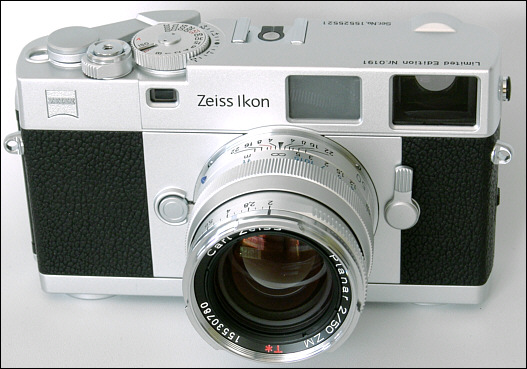 |
|
 |
||||||
|
|
|
|
|
|
|
|
||
As a user and ardent supporter of the older Contax cameras from the 1950s, I've secretly wished for some time that Carl Zeiss AG would bring an updated camera to the market. I like the Carl Zeiss lenses, and I've always been impressed by the quality of construction of the Zeiss Ikon bodies. But considering that Zeiss Ikon went out of business in the early 1970s, I wasn't holding out any hope.
But then ...
Carl Zeiss AG turned quite a few heads at Photokina 2004 in Cologne, Germany, when it unveiled a 35mm rangefinder system. Had Zeiss lost touch with reality by introducing a film camera at a time when the mass market was shifting to digital? Some might think so, but "reading between the lines" might suggest otherwise.

In any case, the new camera was to be called the Zeiss Ikon – a link to the not-too-distant past. Zeiss's marketing efforts were quite good, revealing a small piece of information and photo every couple of weeks in the time leading up to Photokina. There was some thought that was going to be another fully automatic camera, until several people put together all of the pieces to show what looked like a rangefinder.
The system includes a rangefinder body plus seven lenses covering a superwide 15mm Distagon to the so-called portrait lens, an 85mm Sonnar, as well as lens shades and viewfinders. The first series of 1,200 cameras were promoted as Limited Series that come with a leather satchel and special engraving. As well, some people can receive a paperweight to mark the release of the camera. The first cameras are chrome, and a black body was announced for 2006.
Perhaps the most interesting feature of the Zeiss Ikon is that it uses the Leica M mount. Rather than go its own way and create a proprietary mount, Zeiss instead opted to tap into an existing market. It's an interesting move, because it immediately opens a market for its ZM lenses to the world of Leica users.
Two of the lenses – the 15mm and 85mm – are produced at Carl Zeiss's Oberkochen facility in Germany, while the others are made by Cosina of Japan, maker of the Voigtlander Bessa rangefinder cameras, which also is producing the body. Getting straight to the point, this is not a rebadged Bessa, as it has been incorrectly described on Internet postings, newsgroups and photography forums.
Zeiss said production of the 15mm Distagon and the 85mm Sonnar was to be in Germany because Cosina was unable to handle the complex manufacturing of these two lenses, which use floating elements.
The lenses began to trickle onto the market in May 2005. The body, however, was delayed twice before it finally was available to consumers in early November 2005 – some six months after the initial planned date. Zeiss stated on its site that some improvements to the body and shutter were necessary.
What not to expect
The one thing I won't be doing is an endless comparison of the Zeiss Ikon with the Leica. This camera needs to be judged on its own merits and not how it is better or worse than a Leica. That serves no purpose other than to justify the purchase of either camera.
To engage in this tit-for-tat ad nauseum comparison of features is not necessary. As well, I sold my M6, so any comparisons would have to be done from memory, and that wouldn't be fair to either camera. The Leica M cameras and lenses are excellent. No doubt about it.
Here is a chart that compares the technical specs of the Zeiss Ikon, the Bessa R3A and the Leica M7.
Is there room for a Carl Zeiss rangefinder camera system? And is Cosina up to the task of meeting Zeiss's rigid, demanding quality standards? I hope to examine both of these in my ongoing review of the Zeiss Ikon.